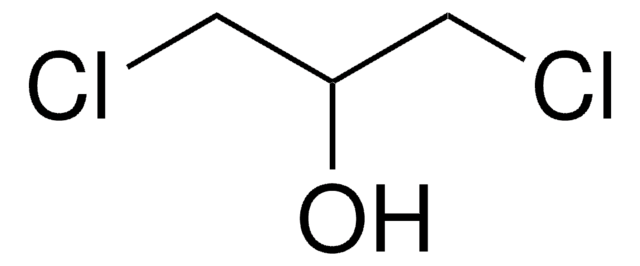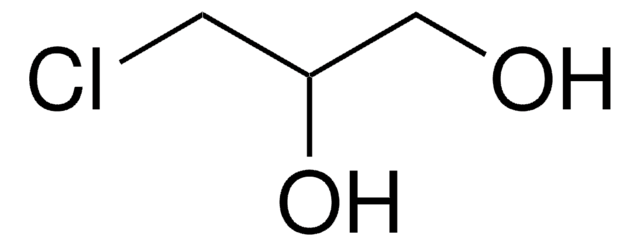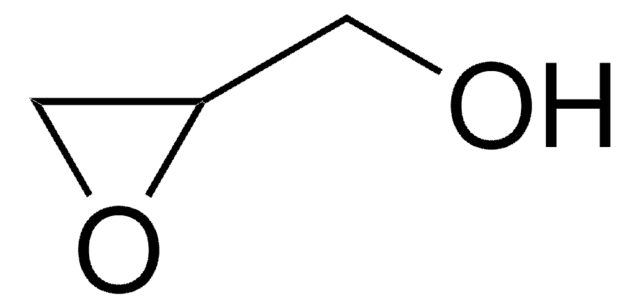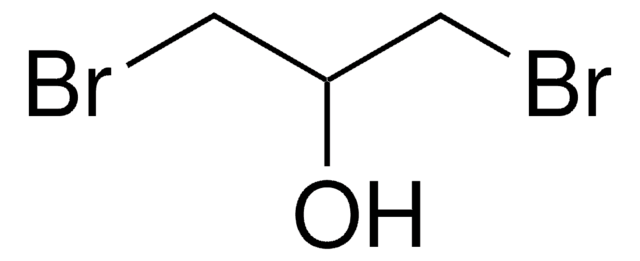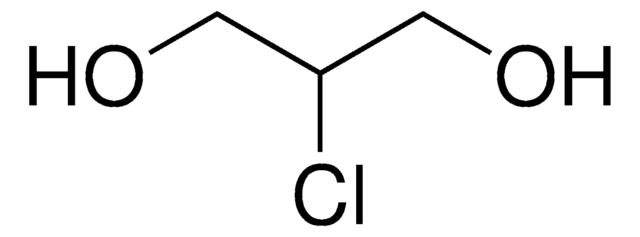36295
2,3-Dichloro-1-propanol
≥97.0% (GC)
Sinónimos:
Glycerol-α,β-dichlorohydrin
Iniciar sesiónpara Ver la Fijación de precios por contrato y de la organización
About This Item
Fórmula lineal:
ClCH2CHClCH2OH
Número de CAS:
Peso molecular:
128.99
Beilstein:
1732060
Número CE:
Número MDL:
Código UNSPSC:
12352100
ID de la sustancia en PubChem:
NACRES:
NA.22
Productos recomendados
Nivel de calidad
Análisis
≥97.0% (GC)
densidad
1.360 g/mL at 20 °C (lit.)
grupo funcional
chloro
hydroxyl
cadena SMILES
OCC(Cl)CCl
InChI
1S/C3H6Cl2O/c4-1-3(5)2-6/h3,6H,1-2H2
Clave InChI
ZXCYIJGIGSDJQQ-UHFFFAOYSA-N
Descripción general
2,3-Dichloro-1-propanol belongs to the group of chloropropanols. Inhibitory effects of 2,3-dichloro-1-propanol on T cell both in vivo and in vitro is reported. Improved enantioselective resolution of (R,S)-2,3-dichloro-1-propanol to (S)-2, 3-dichloro-1-propanol by whole cells of a recombinant Escherichia coli in n-heptane-aqueous biphasic system is reported.
Aplicación
2,3-Dichloro-1-propanol may be employed as carbon and energy supplement for the growth of Pseudomonas putida strain (MC4).
Palabra de señalización
Danger
Frases de peligro
Consejos de prudencia
Clasificaciones de peligro
Acute Tox. 2 Dermal - Acute Tox. 3 Oral - Eye Irrit. 2
Código de clase de almacenamiento
6.1A - Combustible acute toxic Cat. 1 and 2 / very toxic hazardous materials
Clase de riesgo para el agua (WGK)
WGK 3
Punto de inflamabilidad (°F)
199.4 °F
Punto de inflamabilidad (°C)
93 °C
Equipo de protección personal
Eyeshields, Faceshields, Gloves, type ABEK (EN14387) respirator filter
Elija entre una de las versiones más recientes:
¿Ya tiene este producto?
Encuentre la documentación para los productos que ha comprado recientemente en la Biblioteca de documentos.
Los clientes también vieron
Muhammad Irfan Arif et al.
Applied and environmental microbiology, 78(17), 6128-6136 (2012-07-04)
A Pseudomonas putida strain (MC4) that can utilize 2,3-dichloro-1-propanol (DCP) and several aliphatic haloacids and haloalcohols as sole carbon and energy source for growth was isolated from contaminated soil. Degradation of DCP was found to start with oxidation and concomitant
K Fujishiro et al.
Fukuoka igaku zasshi = Hukuoka acta medica, 85(8), 247-250 (1994-08-01)
The toxicity of dichloropropanols (DCPs) was investigated by hematological and blood chemical examination. Solutions of two isomers of DCPs, 1,3-dichloro-2-propanol (DC2P) and 2,3-dichloro-1-propanol (DC1P) were dissolved in saline at a concentration of 100 mg/ml and 0.1 ml of each was
C Aguilar et al.
Journal of chromatography. A, 867(1-2), 207-218 (2000-02-12)
On-line combination of equilibrium sorptive enrichment and gas chromatography is used for the analysis of a group of pollutants varying widely in polarity and volatility in aqueous samples at trace levels. For the ESE process open-tubular traps were used. The
A J Effendi et al.
Applied and environmental microbiology, 66(7), 2882-2887 (2000-07-06)
2,3-Dichloro-1-propanol is more chemically stable than its isomer, 1, 3-dichloro-2-propanol, and is therefore more difficult to degrade. The isolation of bacteria capable of complete mineralization of 2, 3-dichloro-1-propanol was successful only from enrichments at high pH. The bacteria thus isolated
Jing Lu et al.
International immunopharmacology, 17(2), 321-328 (2013-07-16)
2,3-Dichloro-1-propanol (2,3-DCP) is a member of a group of chemicals known as chloropropanols. Currently, immunotoxicity of 2,3-DCP has not been reported. In the present study, we studied its inhibitory effects on T cell both in vivo and in vitro. The
Nuestro equipo de científicos tiene experiencia en todas las áreas de investigación: Ciencias de la vida, Ciencia de los materiales, Síntesis química, Cromatografía, Analítica y muchas otras.
Póngase en contacto con el Servicio técnico